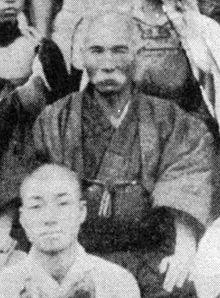- Okinawan martial arts
-
Okinawan martial arts refers to the martial arts which originated among the indigenous people of Okinawa Island in Japan, most notably karate, tegumi, and Okinawan kobudō.
Due to its central location, Okinawa was influenced by various cultures such as Japan and China, with a long history of trade and cultural exchange with China that greatly influenced the development of martial arts on Okinawa.
Contents
History
In 1429, the three kingdoms on Okinawa unified to form the Kingdom of Ryūkyū. When King Shō Shin came into power in 1477, he banned the practice of martial arts. Tō-te and kobudō continued to be taught in secret. The ban was continued in 1609 after Okinawa was invaded by the Satsuma Domain of Japan. The bans contributed to the development of kobudō, which uses common household and farming implements as weaponry.[1] The Okinawans combined Chinese martial arts with the existing local variants to form Tōde (唐手 Tuudii, T'ang hand, China hand),[2] sometimes called Okinawa-te (沖縄手).[1]
By the 18th century, different types of Te had developed in three different villages – Naha, Shuri, and Tomari. The styles were named Naha-te, Shuri-te, and Tomari-te, respectively. Practitioners from these three villages went on to develop modern karate.[3] Well into the 20th century, the martial arts of Okinawa were generally referred to as te 手, which is Japanese for "hand". Te often varied from one town to another, so to distinguish among the various types of te, the word was often prefaced with its area of origin; for example, Naha-te, Shuri-te, or Tomari-te.
Naha-te, Shuri-te and Tomari-te belong to a family of martial arts that were collectively defined as Tode-jutsu or To-de.[4][5]
By the 1930s, a number of formal organizations were founded to oversee Okinawan martial arts, and due to their influence, the word karate came to be widely accepted as a generic term for all sorts of Okinawan unarmed martial arts. With the popularity of the term karate, the practice of naming a type of martial art after its area of origin declined.
Shuri-te
 Ankō Itosu, often called the "Father of modern karate."
Ankō Itosu, often called the "Father of modern karate."
Shuri-te (首里手, Okinawan: Suidii) is a pre-World War II term for a type of martial art indigenous to the area around Shuri, the old capital city of the Ryūkyū Kingdom.
Important Okinawan masters of Shuri-te:
- Sakukawa Kanga
- Matsumura Sōkon
- Itosu Ankō
- Asato Ankō
- Chōyū Motobu
- Motobu Chōki
- Yabu Kentsū
- Chōmo Hanashiro
- Funakoshi Gichin
- Kyan Chōtoku
- Chibana Chōshin
- Mabuni Kenwa
- Tōyama Kanken
- Tatsuo Shimabuku
Important katas:
The successor styles to Shuri-te include Shōtōkan-ryū, Shōtōkai, Wadō-ryū, Shitō-ryū, Motobu-ryū, Shuri-ryū, Shōrin-ryū, Shudokan, Keishinkan, and Shōrinji-ryū.
Tomari-te
Tomari-te (泊手, Okinawan: Tumai-dii) refers to a tradition of martial arts originating from the village of Tomari, Okinawa. Tomari-te arose largely through the influence of Chinese diplomats and other personages skilled in Quan fa, such as Wang Ji, Anan, and Ason, in the late 17th century.[citation needed]
Important Okinawan masters of Tomari-te:
- Matsumora Kōsaku
- Oyadomari Kokan
- Yamazato Gikei
- Motobu Chōki
- Kyan Chōtoku
Important katas:
The successor styles to Tomari-te include Motobu-ryū, Matsubayashi-ryu, Shōrinji-ryū, Gohaku-Kai and Matsumora-ryū Kōtokukai.
Naha-te
 The genealogy of Naha-te[citation needed]
The genealogy of Naha-te[citation needed]
Naha-te (那覇手, Okinawan: Naafa-dii) is a pre-World War II term for a type of martial art indigenous to the area around Naha, the old commercial city of the Ryūkyū Kingdom and now the capital city of the island of Okinawa.
Naha-te was primarily based on the Fujian White Crane systems of Southern China, which trickled into Okinawa in the early 19th century through Kumemura (Kuninda), the Chinese suburb of Naha, and continued developing and evolving until being finally formalized by Higaonna Kanryō in the 1880s.[6][unreliable source?]
Important Okinawan masters of Naha-te:
- Kogusuku Isei
- Maezato Ranhō
- Arakaki Seishō
- Higaonna Kanryō
- Miyagi Chōjun
- Kyoda Jūhatsu
- Mabuni Kenwa
Important katas:
The successor styles to Naha-te include Gōjū-ryū, Tōon-ryū (developed by the students of Higaonna Kanryō), Kogusuku-ryū, and others.
See also
References
- ^ a b Okinawan Masters. msisshinryu.com. Retrieved on 2011-06-20.
- ^ History of Karate | Martial Arts History. Martialarthistory.com (1957-04-26). Retrieved on 2011-06-20.
- ^ History of Karate. msisshinryu.com. Retrieved on 2011-06-20.
- ^ "Tomari-Te: The Place of the Old To-De". http://www.msisshinryu.com/history/tomari-te/. Retrieved July 25, 2005.
- ^ "Koshinrin School of Karate: Katas". http://www.koshinrin.ca/katas.htm. Retrieved July 25, 2005.
- ^ Camara, Fernando. "Fujian White Crane Fist: An Outline of historical elements in the development of Nafadi". Archived from the original on 2008-05-14. http://web.archive.org/web/20080514044548/http://www.geocities.com/alaumirm/s_pagina6.htm. Retrieved 2007-05-10.[unreliable source?]
External links
Karate Origin Naha-te · Shuri-te · Tomari-teStyles Budōkan · Chitō-ryū · Gensei-ryū · Gōjū-ryū · Gosoku-ryu · Isshin-ryū · Kobayashi Shōrin-ryū · Koei-Kan · Kuma-Ryu · Matsubayashi-ryū · Motobu-ryu · Mushindo Kempo · Ryū Te · Ryūei-ryū · Shitō-ryū · Shohei-ryu · Shōrin-ryū · Shōrei-ryū · Shorinjiryu Kenkokan · Shōrinji-ryū · Shōtōkai · Shotokan · Shūdōkan · Shūkōkai · Shuri-ryū · Tōon-ryū · Uechi-ryū · Wadō-ryū · Yoseikan-ryu · YoshukaiFull contact styles Techniques Comparison of styles Categories:
Wikimedia Foundation. 2010.



